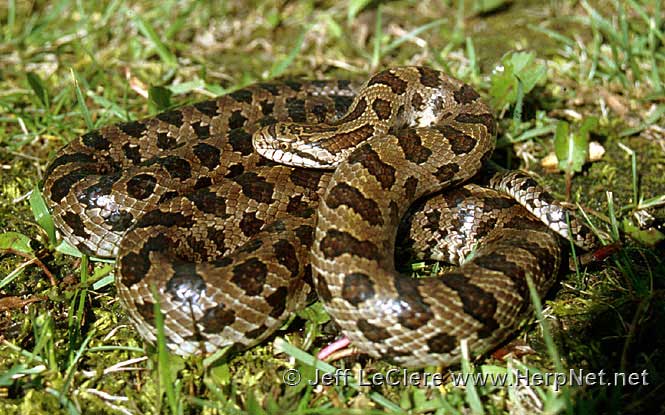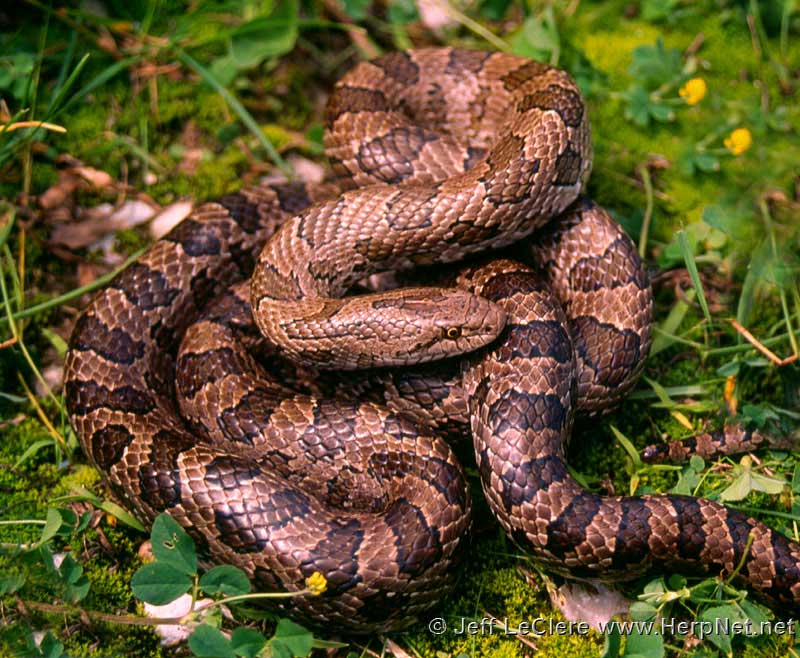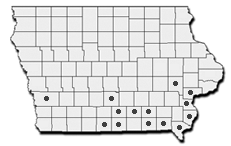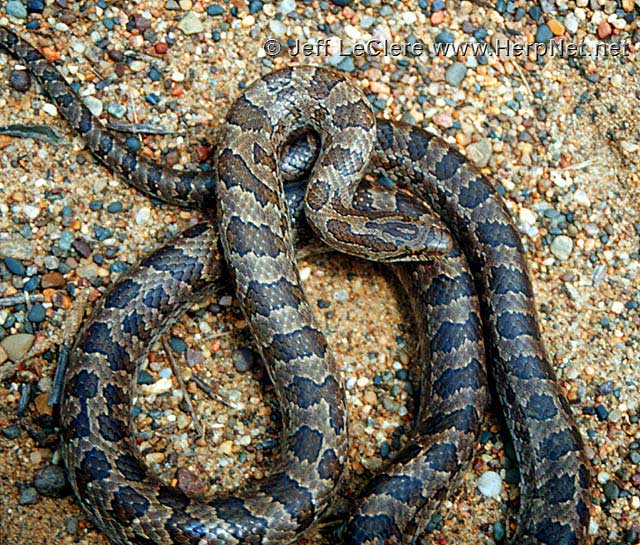Prairie Kingsnake (Lampropeltis calligaster)
by Jeff LeClere

Status
PROTECTED and Species of Greatest Conservation Need. It is illegal to kill or collect this species by law in Iowa. These snakes are common in the southern two tiers of counties. We are looking for any reports north of those counties.
Description
Harmless to humans. A medium sized Iowa snake that is 30 to 42 inches in length (Conant and Collins, 1991). The prairie kingsnake’s general coloration is quite variable. Some specimens can be beautifully light colored, having a light gray or brown ground color and darker body blotches. The blotches are usually brown, but some snakes may have reddish or greenish blotches. Some, especially older specimens, may lose the spots and develop four longitudinal stripes down the back. This appears to be rare in Iowa, however. There are two rather oblong blotches behind the head; and an alternating row (sometimes two) of dark lateral spots on the sides. These lateral spots vary in size, but are never as big as the dorsal blotches.
The belly is cream or yellowish with brown checkers scattered randomly about the venter. There is often a dark line from the eye to the angle of the jaw, and there may be dark sutures on the lips. The prairie kingsnake’s scales are smooth and the anal plate is single. The prairie kingsnake closely resembles the fox snake. Fox snakes have weakly keeled scales, a divided anal plate, and less markings on the head.

Subspecies
There are no subspecies currently recognized.
Range
Prairie kingsnakes are found in the southern third of Iowa.


Habitat
These snakes utilize a wide variety of habitats. They are found in prairies, (including sand prairies), open grassland, fields, pastures, in ditches along cultivated field and roads, woodlands, and some stream valleys and blufflands. They are most common in grasslands along forest edges, and are only occasionally found in blufflands or sand prairies. They also do not appear to be found deep in heavy woodlands very often.
Habits
Prairie kingsnakes are active from April to October in Iowa. They are diurnal in the spring and fall becoming largely nocturnal in summer. This is the most common large constricting snake in southern Iowa. I find that prairie kings are the most commonly road-killed snake in this area.

I have noticed a rather interesting distributional relationship between prairie kingsnakes and fox snakes in Iowa. While the fox snake is one of the most common species in the northern two thirds of the state, the prairie kingsnake seems to replace it in the south. However, the fox snake still has a stronghold in the Mississippi and Missouri River Valleys. I rarely find both species in the same area, but I have seen DOR specimens of both species within a few hundred feet of one another in Louisa County. Undoubtedly this occurs in other areas as well, but in south central Iowa, there is an obvious reduction in the number of fox snakes and an increase in the number of prairie kingsnakes. Minton (1972) mentions the same relationship between these species in Indiana. The prairie kingsnake utilizes the same habitats as the fox snake and may be slightly more diverse in habitat usage. The prairie kingsnake is certainly more diverse in prey acceptance than the fox snake, and in this respect gives the prairie kingsnake the advantage over the fox snake in these areas.
Prairie kingsnakes are active snakes that wander a great deal, but they are still somewhat secretive. They are often seen on the roads in the morning or at dusk, and later after sunset in warm summer months. Individuals are rather passive when picked up, but a few will bite. They also release musk and vibrate their tails when agitated.
Prairie kingsnakes mate soon after emergence from their hibernacula (Johnson, 1992). The male will bite the head or neck of the female during courtship and keep a hold during copulation. Collins (1993) reports egg laying in June or July. The average clutch size is 11 (Minton, 1972). The eggs hatch in September. The young look like adults, but are often more reddish in overall coloration; some specimens retain this color, but most will become much darker as adults.
Food
Prairie kingsnakes are dietary generalists and feed on a wide variety of prey. Mammals, birds, birds eggs, snakes, lizards, frogs, and reptile eggs have been reported as food. Prairie kings, like other kingsnakes, will eat venomous snakes. They are immune to the venom of North American venomous snakes and such snakes will use other methods to escape kingsnakes. Instead of striking, the the venomous species will throw loops of coils at the kingsnake in an attempt to bat the head and make a quick escape. Prairie kingsnakes are even known to consume other prairie kingsnakes (Smith, 1961). Kingsnakes are powerful constrictors.
Prairie kingsnakes are often found around farms and barns. They are looking for mice and other prey. Constricting snakes are very beneficial to farmers. Unfortunately, many people are ignorant of this fact and kill the snake believing it to be venomous. This is foolish; because of the snakes’ broad diet, the kingsnake will not only help rid the farmer of mice, but this harmless species will actually help rid the farmer of any venomous species that happen to be around as well.